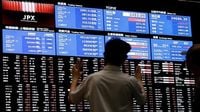In a striking turn of events, foreign institutional investors (FIIs) have injected a remarkable ₹14,670 crore into the Indian cash market over the past three trading sessions, from April 15 to April 17, 2025. This surge in investment marks one of the most significant buying trends in recent times, signaling a resurgence of optimism in the Indian equity market amidst shifting global and domestic economic signals.
Despite the influx of foreign capital lifting market sentiment, it follows a challenging period where FPIs had been offloading shares, with total sales reaching ₹23,999 crore as of April 19, 2025. However, the last three trading days saw a noticeable shift in FII behavior, indicating a renewed interest in Indian equities after a prolonged period of selling.
According to Prashanth Tapse, Research Analyst and Senior Vice President of Research at Mehta Equities, the recent uptick in FII investments is attributed to several factors. "The decline in the US Dollar Index around 100, coupled with expectations of further weakening, has prompted foreign investors to return to India, which is offering better risk-adjusted returns compared to other emerging markets," he explained. He noted that low inflation, stable crude prices, and better-than-expected Q4FY25 earnings, particularly from the banking sector, have contributed to this renewed confidence.
Additionally, the postponement of US tariffs by 90 days has eased global trade tensions, further fueling market optimism. Tapse emphasized that while volatility may persist, the market's performance near its 200-day moving average (DMA) resistance level will be crucial. "If we close above 20,050 on a weekly basis, the strength would continue in the market and signal potential upside. However, if the market closes below 23,300, we could see more selling pressure largely driven by profit booking," he cautioned.
Dr. VK Vijayakumar, Chief Investment Strategist at Geojit Investments, added that the expected lackluster growth in both the US and China this year, contrasted with India's projected growth rate of 6% for FY26, positions India favorably in the global economic landscape. This relative advantage is likely to result in superior market performance.
"The trend of FII buying is expected to continue, even amid uncertainties. Investment interest is likely to concentrate on domestic consumption themes, including financial services, telecommunications, aviation, and healthcare," Vijayakumar noted.
As the market navigates through this phase of recovery, investors are advised to approach the upcoming earnings with caution. Mohit Gulati, CIO and Managing Partner of ITI Growth Opportunities Fund, remarked, "Investors are reflecting concerns over sluggish demand and sectoral headwinds. However, there is a sense of guarded optimism building, as the RBI's recent interest rate cut—and the expectation of an additional 50-75 basis points reduction over the next 100 days—are poised to lower borrowing costs and stimulate credit offtake. This monetary easing is seen as a catalyst that could revive corporate growth and set the stage for a stronger earnings trajectory in the upcoming quarters, even as global uncertainties linger."
On April 15, 2025, FPIs became net buyers, injecting ₹6,065 crore into the Indian stock market, marking the end of a nine-day selling spree that resulted in total outflows of ₹38,992 crore. The last time FPIs were net buyers was on March 27, 2025, when they acquired equities worth ₹11,111.25 crore.
This shift in outlook among foreign investors comes on the heels of US President Donald Trump relaxing some of his stringent tariff policies on major trading partners. Investors are also closely observing ongoing trade negotiations, creating optimism that a wider trade agreement could alleviate global market uncertainties.
Looking ahead, analysts are optimistic about the potential for continued FII inflows into Indian markets, supported by stable domestic macros and improving corporate earnings. Tapse noted, "If technical levels align with fundamentals—especially with a decisive move above key resistance zones—we could witness a broader rally supported by institutional buying."
In the context of broader market trends, Devang Mehta, a market expert, highlighted that despite global headwinds, Indian markets have shown remarkable resilience. After hitting a low of around 22,100 on April 7, 2025, the market bounced back sharply with a 7% rally in benchmark indices. This recovery has also been mirrored in midcap and smallcap segments, reflecting broad-based market optimism.
Mehta pointed out that many negatives that have plagued the market since last September seem to be priced in now. He noted improvements in macroeconomic indicators, with GDP numbers bouncing back and inflation trending lower, alongside the Reserve Bank of India's supportive monetary stance. With two rate cuts already implemented and possibly more to come, liquidity remains abundant, further bolstering the positive outlook.
As the earnings season unfolds, Mehta emphasized that the focus should shift toward sectors related to discretionary and non-discretionary consumption, as well as the BFSI (banking, financial services, and insurance) space. These sectors have been benefiting from the ongoing financialization of the Indian economy, offering both stability and long-term capital appreciation.
In conclusion, the Indian equity market is navigating a complex landscape of global volatility while displaying signs of resilience. As FIIs return with renewed interest, investors are encouraged to reassess their portfolios, focusing on quality businesses and sectors poised for growth amidst changing economic conditions.







